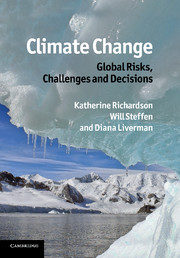Book contents
- Frontmatter
- Contents
- Writing team
- Foreword
- Preface
- List of acronyms and abbreviations
- Part I Climatic trends
- 1 Identifying, monitoring and predicting change in the climate system
- 2 The oceans and the climate system
- 3 Sea-level rise and ice-sheet dynamics
- 4 Carbon cycle trends and vulnerabilities
- Part II Defining ‘dangerous climate change’
- Part III Equity issues
- Part IV Mitigation and adaptation approaches
- Part V Meeting the challenge
- Index
- Plate section
- References
3 - Sea-level rise and ice-sheet dynamics
Published online by Cambridge University Press: 04 April 2011
- Frontmatter
- Contents
- Writing team
- Foreword
- Preface
- List of acronyms and abbreviations
- Part I Climatic trends
- 1 Identifying, monitoring and predicting change in the climate system
- 2 The oceans and the climate system
- 3 Sea-level rise and ice-sheet dynamics
- 4 Carbon cycle trends and vulnerabilities
- Part II Defining ‘dangerous climate change’
- Part III Equity issues
- Part IV Mitigation and adaptation approaches
- Part V Meeting the challenge
- Index
- Plate section
- References
Summary
‘You melt, we drown’
Sea-level rise has emerged as one of the most intensely studied and discussed aspects of climate change in recent years. The period of relative stability of sea level over the past 6000–7000 years (Harvey and Goodwin, 2004) has now ended, and sea level is undoubtedly rising in the post-industrial period (IPCC, 2007a). Given the massive heat capacity of the ocean, the Earth is already committed to many more centuries of sea-level rise due to thermal expansion alone. The dynamics of the large polar ice sheets and the rapid retreat of glaciers and ice caps will significantly add to the magnitude of sea-level rise. The critical questions are: how much and how fast? The implications for long-lived coastal infrastructure, coastal ecosystems, and low-lying urban areas and settlements are significant. This chapter explores our current understanding of sea-level rise, including observations of sea-level rise in the more recent past as well as insights from deeper in Earth's history, projections of sea-level rise out to the end of this century, the dynamics of the large polar ice sheets in Greenland and Antarctica, and the consequences of sea-level rise for contemporary society.
Observations of sea-level rise
Observations of sea level from 1870 to 2001 (Figure 3.1) show an increase of about 20 cm over the period (Church and White,2006). An extension of the record with more recent data shows that the rate of sea-level rise has increased within the past two decades, from 1.6 mm yr−1 in the 1961–2003 period to 3.1 mm yr−1 in the 1993–2003 period (Church and White, 2006; Domingues et al., 2008).
- Type
- Chapter
- Information
- Climate Change: Global Risks, Challenges and Decisions , pp. 50 - 74Publisher: Cambridge University PressPrint publication year: 2011



